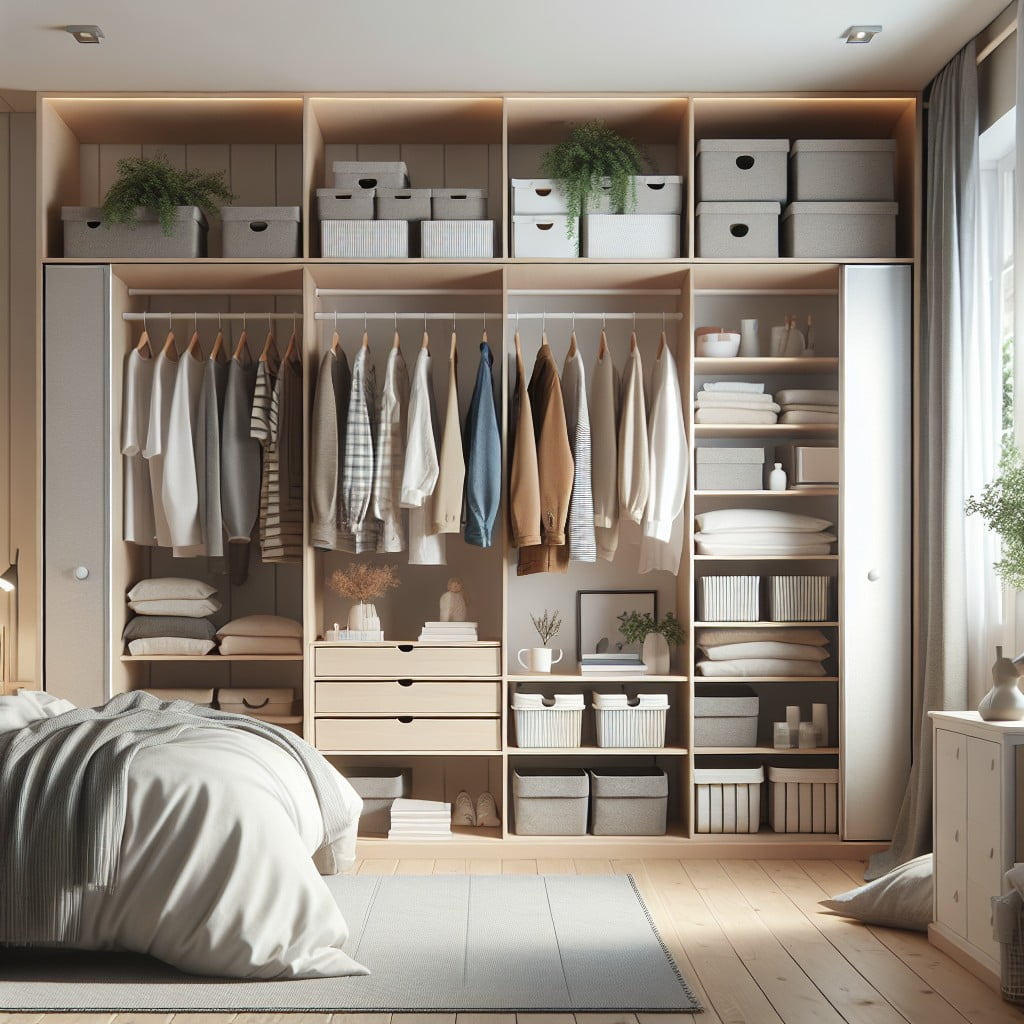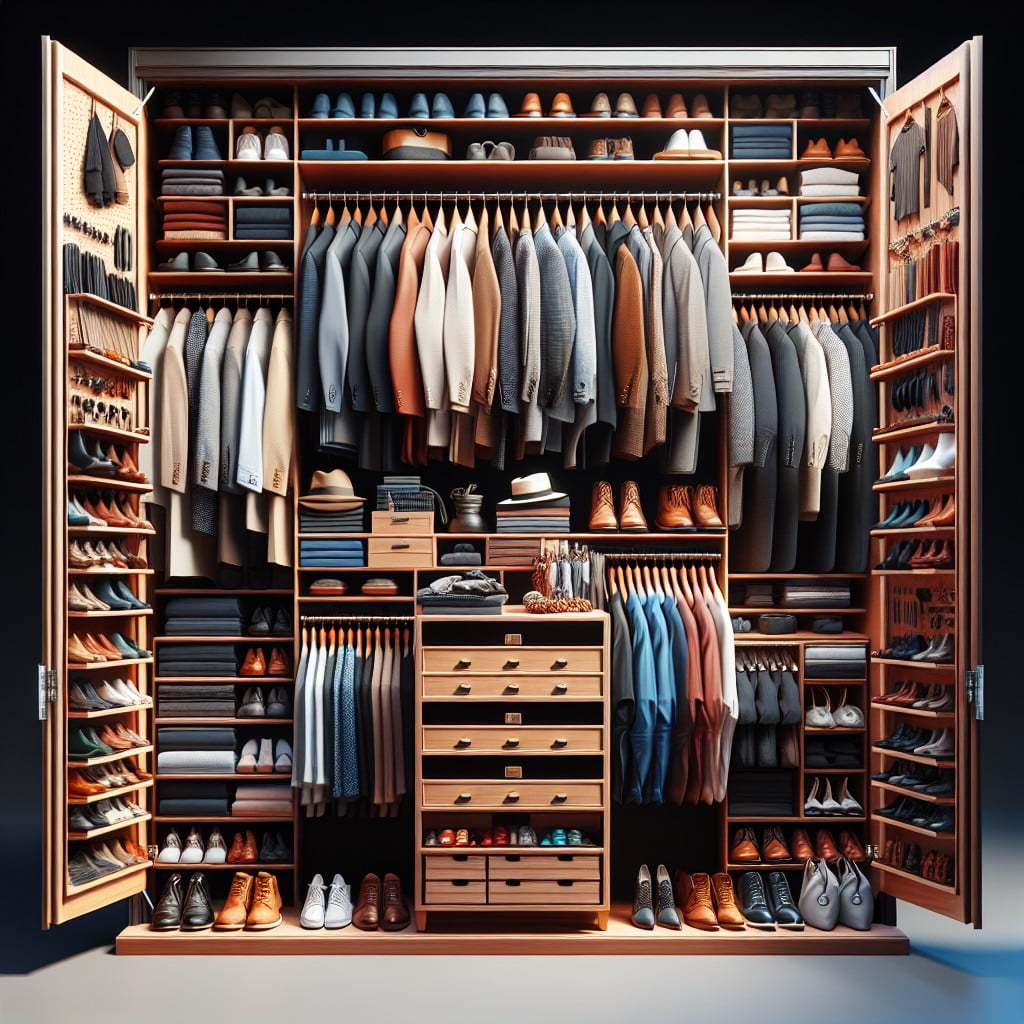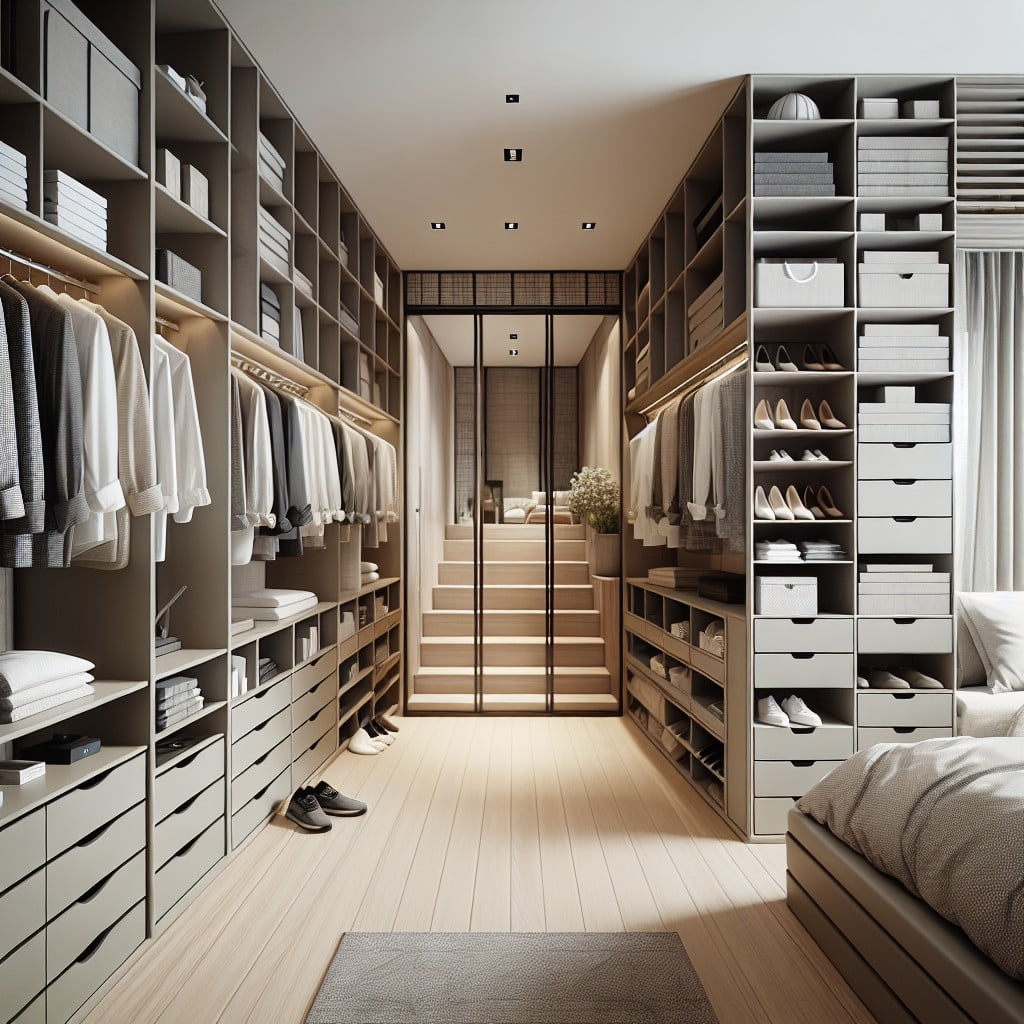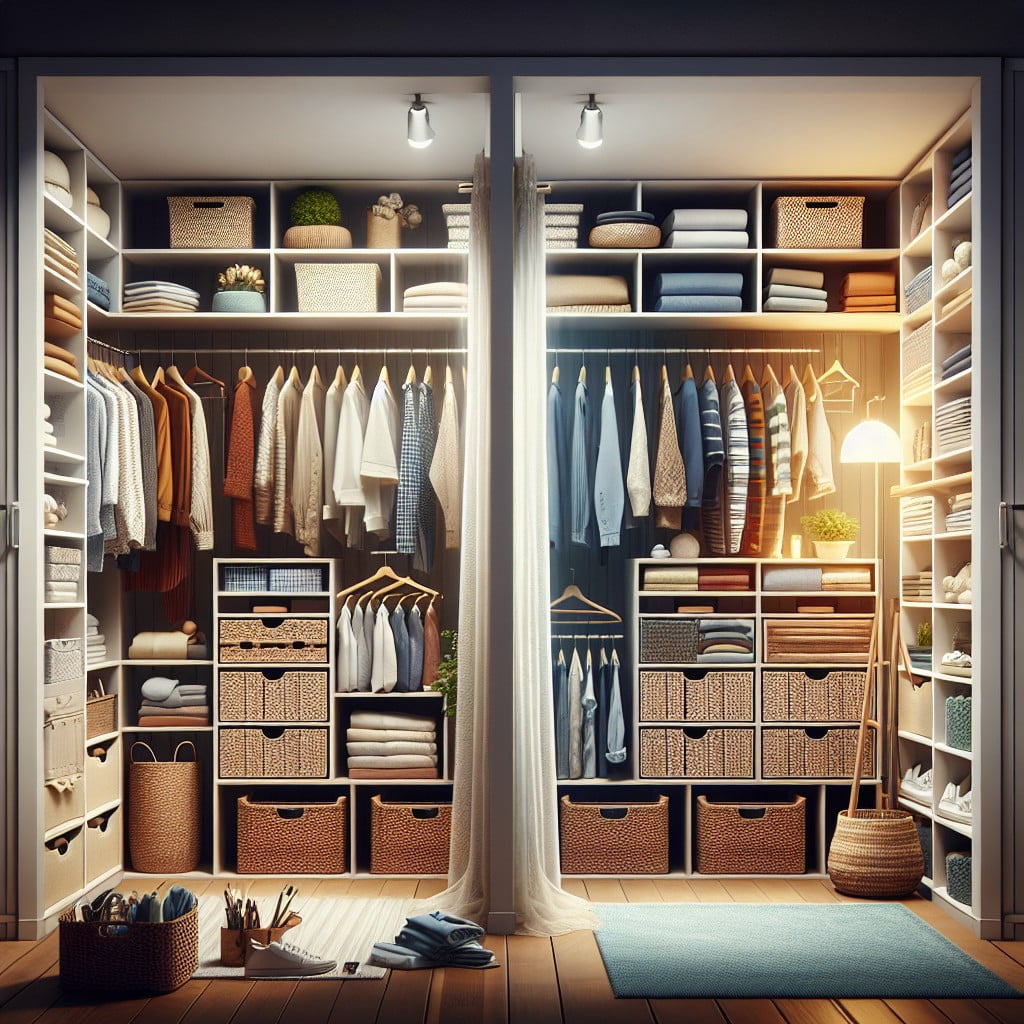Last updated on
Transforming ordinary closets into stylish, doorless designs is easier than you might think, simply because these designs remove barriers, enhance accessibility and add a chic, modern touch to any room.
Key takeaways:
- Enhanced Accessibility: Easy reach, quick selections, effortless organization.
- Aesthetic Display: Show off clothing and accessories as decor.
- Space-Saving Solution: No need for extra space for doors.
- Economic Option: Eliminate the need for costly custom doors.
- Air Flow Improvement: Better ventilation, fresher clothes.
The Charm of a Closet Without Doors

Embracing the open concept, a doorless closet adds an element of casual sophistication to a room while providing a showcase for personal style. Here are a few points to illuminate the allure of this design choice:
– Enhanced Accessibility: Without doors, items are easily reachable, facilitating quick selections and effortless organization. – Aesthetic Display: Show off your favorite clothing and accessories, turning them into part of the room’s decor. – Space-Saving Solution: Small areas benefit from the absence of doors, which require extra space for opening and closing. – Economic Option: Eliminating the need for doors can reduce expenses, especially when considering costlier custom door options. – Air Flow Improvement: A closet without doors allows for better ventilation, keeping clothes fresher.Each of these points contributes to the practical beauty of an open closet, highlighting function alongside form.
Design Flexibility and Visual Appeal

Opting for a doorless closet system can significantly enhance the aesthetic of a room, offering a unique opportunity for personal expression. Open closets serve as a display for fashion collections, much like art in a gallery. They can also make a space feel larger since the line of sight is not interrupted by closed doors, creating a more seamless transition between areas in a room.
In terms of design flexibility:
- You have the liberty to stage your belongings as part of your room’s decor, showcasing your style and keeping your favorite pieces within easy reach.
- Color coordination and decorative storage boxes turn necessary storage into an attractive feature.
- Innovative lighting solutions, such as LED strips, cast a warm glow and elevate the ambiance, making your closet both functional and stylish.
- Curated displays can leverage the visual balance, using varying heights and textures to draw the eye and add interest.
Remember, an open closet doesn’t mean compromising on design; it means embracing creativity and openness in home styling.
Mastering the Art of Organizing a Closet Without Doors

To keep an open closet orderly, think like a retailer. Envision your space as a boutique where everything has its designated spot. Start by categorizing your items – clothing, accessories, shoes – and then subdivide by type or color for a harmonious look.
Use uniform hangers to maintain a sleek, cohesive aesthetic. Invest in attractive bins or baskets for smaller items to avoid clutter. Transparent storage can be both stylish and functional, allowing you to see contents at a glance while keeping things tidy.
Consider floating shelves for folded garments or display-worthy accessories. They offer easy access while doubling as decor. For items less frequently used, or not as visually pleasing, tuck them away in decorative boxes on higher shelves.
Lastly, adopt the habit of regular purging. A doorless closet stays manageable only with periodic editing to ensure everything within view deserves its place.
Tips for Managing an Open Closet

To ensure your open closet remains both stylish and functional, consider adhering to these streamlined strategies:
1. Curated Selection: Only keep items you use frequently or love. This approach not only cuts down clutter but also makes your choices in the morning easier.
2. Uniform Hangers: A consistent hanger type creates a neat appearance, drawing attention away from the lack of doors and towards your well-organized collection.
3. Categorization: Group clothes by type or color to find what you’re looking for swiftly and to add a visually pleasing structure.
4. Use of Boxes and Bins: Stow away out-of-season clothes or seldom-used items in attractive boxes or bins that complement your room’s decor.
5. Invest in a good organizer: Shelving units, drawer dividers, and storage cubes can all help maintain order and prevent piles of clothes from forming.
6. Add Some Decor: Incorporate a few decorative items, such as a vase or artwork, to transform the space into a part of your room’s aesthetic, rather than just storage.
By implementing these tips, you can enjoy the openness of your closet without compromising on organization or style.
Navigating the Challenges: Dust and Privacy
A doorless closet means your belongings are more exposed, which can lead to two main issues: dust accumulation and a lack of privacy. To combat these, consider the following strategies:
Combatting Dust:
- Opt for storage boxes or bins with lids for less-used items to keep them dust-free.
- Use garment bags to shield delicate clothing or seldom-worn attire.
- Incorporate easy-to-clean materials within the closet, such as metal, glass, or sealed wood.
Maintaining Privacy:
- Install a sleek curtain or a stylish room divider that can be easily drawn when needed.
- Place your most personal items in opaque bins or drawers.
- Strategically position the closet behind a furniture piece like a dresser or a folding screen for an added layer of seclusion when necessary.
By proactively addressing these elements, you can preserve the practicality and aesthetics of your open closet design.
Closet Door Alternatives and Ideas
Exploring alternative options for traditional closet doors enhances both the function and style of your space. Here are a few creative solutions to consider:
1. Curtains: Soft and versatile, curtains can introduce color and texture, while easily sliding out of the way for access.
2. Room Dividers: Folding screens add an artistic touch and can be moved as needed, offering flexibility and elegance.
3. Beaded Strings: For a bohemian flair, strings of beads can add a playful element that separates your closet space without a solid barrier.
4. Open Shelving: Replacing the closed area with an organized display of open shelves keeps items accessible and visible.
5. Glass Partitions: Frosted or clear glass maintains an open feel and can make a small room appear larger, while still distinguishing the closet area.
Each of these choices invites customization to align with your decor and meet your storage needs, transforming the closet area into an integral part of your room’s design.
Choosing the Right Closet Door Alternatives: Optimizing Space and Functionality
Selecting an alternative to the traditional closet door can transform your space and enhance functionality. Curtains offer an easy, flowing look and can be pulled aside quickly. They come in a variety of fabrics and patterns to suit your decor style. For a sleeker and more industrial vibe, consider using a high-quality tension rod and canvas drop cloth.
If minimalism is your goal, sliding panels are a smart choice. They provide a seamless transition from the closet to the rest of the room, maintaining a clean line of sight. Options include frosted glass for a touch of privacy while still allowing light to permeate.
For those who prefer a more defined separation without installing doors, a room divider screen can be an artistic and practical solution. They are portable and can be matched to your room’s theme, standing as a piece of decor on their own.
For a more open-concept feel, integrate the closet into your room with matching shelves and hanging rods. Incorporate storage boxes and baskets to keep items sorted and accessible, providing a cohesive and organized appearance.
Adapting Closets to Lifestyle Changes
As life progresses, needs evolve, and the spaces within a home should reflect that dynamic nature. Closets without doors are particularly adaptable to changing lifestyles. For instance, what once was a tight space for a college student’s wardrobe can transition into a storage area for a young professional’s expanded attire or a new parent’s plethora of baby essentials.
Bolt-on shelves or hanging storage units can be easily installed, offering flexibility for growing shoe collections or outdoor gear. Additionally, considering modular storage options allows for the quick reconfiguration of the layout to best suit the current demands of life’s various stages—a craft storage today might need to transform into a space for formal wear tomorrow.
Essentially, choose furnishings and organizers that can be repurposed as needs change to ensure that the closet remains both useful and aesthetically pleasing over time.
Regular Cleaning and Maintenance
Maintaining a fresh and orderly appearance for an open closet requires a touch more diligence than one with doors. Dust tends to settle on exposed items, meaning more frequent dusting and vacuuming are in order. Aim for a once-over with a microfiber cloth weekly to remove surface dust from clothing, shelves, and other items.
Incorporate fabric refreshers or drawer sachets to keep clothes smelling clean between washes. Organize clothes by type and color not only for visual appeal but also to streamline the process of finding what you need, minimizing the disruption of neatly stacked items.
When it comes to spill prevention, consider placing heavier, less frequently used items on lower shelves and lighter, everyday items within easy reach. This minimizes the risk of knocking things over and creating a mess. Remember, the more accessible and easy to use the storage system, the more likely it is to stay tidy.
Creating a Sense of Ownership Through Personal Touches
Injecting a personal flair into an open closet turns a simple storage area into a showcase of individuality. Select accessories that resonate with your style; consider using unique hangers, eclectic storage boxes, or distinctive bins that serve as functional decor.
Incorporate lighting to not only illuminate your wardrobe but also to add ambiance. Consider string lights, LED strips, or even a small, stylish lamp.
Hang artwork or photos on the adjacent wall space to make the area feel more intimate and connected to the rest of the room.
Use a consistent color scheme or material choices to create harmony in your display. By focusing on these personalized elements, your closet transforms into a curated part of your living space that proudly reflects who you are.
FAQ
Can you have a closet without a door?
Yes, you can indeed have a closet without a door; it often additionally serves as a decorative display and embodies a unique design philosophy.
Does your closet need a door?
Closet doors aren’t necessary if the wardrobe is well-organized, free from clutter, and consistently maintained.
What can I use instead of folding closet doors?
For a compact room, utilizing sliding doors is an excellent alternative to folding closet doors as they shift to the side inside the closet, hence saving space.
Should I remove closet doors?
Removing closet doors, especially from bedroom closets accessed only through a bathroom, may not provide significant physical space, but it substantially enhances visual space, making it an aesthetically pleasing option.
What are the pros and cons of open closet concepts?
Open closet concepts provide easy access and attractive display options but may lead to clutter and lack of privacy.
How can one organize a closet without a door effectively?
One can organize a closet without a door effectively by utilizing storage containers, arranging items by category or frequency of use, and incorporating functional design elements such as shelving or hanging systems.
Are there any laws or housing standards related to door-less closets?
Yes, certain housing codes and standards stipulate that closets must possess doors for fire safety and privacy reasons.
Recap:




